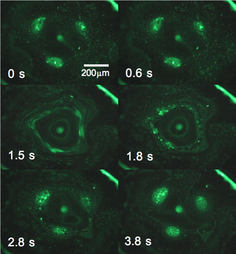A standing surface acoustic wave on the substrate beneath a drop will induce a similar low amplitude standing capillary wave vibration along the drop free surface at the same frequency (typically MHz order). In addition, the drop also vibrates at its natural vibration frequency (typically kHz order) due to capillary-viscous resonance. If the drop were to contain a suspension of colloidal particles, islands of these particles are observed to form at the intersection between the nodal lines associated with the former low amplitude low frequency standing wave vibration and the circular nodal ring associated with the bulk capillary-viscous vibration of the drop, as shown above.
At higher powers commensurate with the onset of bulk internal recirculation (acoustic streaming), a curious phenomenon occurs in which the drop randomly cycles between colloidal island formation in a quiescent fluid and erasure (dispersion) of these patterns when the fluid starts to move. The fluid direction (clockwise and anti-clockwise) appears to switch randomly.
At higher powers commensurate with the onset of bulk internal recirculation (acoustic streaming), a curious phenomenon occurs in which the drop randomly cycles between colloidal island formation in a quiescent fluid and erasure (dispersion) of these patterns when the fluid starts to move. The fluid direction (clockwise and anti-clockwise) appears to switch randomly.
|
Relevant Publications
|



